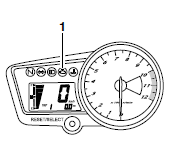Yamaha YZF-R125 Service Manual: Ecu self-diagnostic function
The ECU is equipped with a self-diagnostic function in order to ensure that the fuel injection system is operating normally. If this function detects a malfunction in the system, it immediately operates the engine under substitute characteristics and illuminates the engine trouble warning light to alert the rider that a malfunction has occurred in the system. Once a malfunction has been detected, a fault code is stored in the memory of the ECU.
- To inform the rider that the fuel injection system is not functioning, the engine trouble warning light flashes when the start switch is being pushed to start the engine.
- If a malfunction is detected in the system by the self-diagnostic function, the ECU provides an appropriate substitute characteristic operation, and alerts the rider of the detected malfunction by illuminating the engine trouble warning light.
- After the engine has been stopped, the lowest fault code number is
indicated by the engine trouble
warning light (or displayed on the FI diagnostic tool). It remains stored in
the memory of the ECU until
it is deleted.

1. Engine trouble warning light
Engine trouble warning light fault code indication
Digit of 10: Cycles of 1 sec. on and 1.5 sec. off.
Digit of 1: Cycles of 0.5 sec. on and 0.5 sec. off.
Example: 42 
a. Light on
b. Light off
c. 1
d. 1.5
e. 0.5
f. 3
Engine trouble warning light indication and fuel injection system
operation 
* The warning light flashes when any one of the conditions listed below is present and the start switch is pushed:
19: Blue/yellow ECU lead (broken or disconnected)
30: Lean angle sensor (latch up detected)
33: Faulty ignition
39: Fuel injector (open or short circuit)
41: Lean angle sensor (open or short circuit)
50: ECU internal malfunction (memory check error)
Checking the engine trouble warning light
The engine trouble warning light comes on for 3 seconds after the main switch
has been set to "ON". If
the warning light does not come on under these conditions, the warning light
(LED) may be defective.
a. Main switch "OFF"
b. Main switch "ON"
c. Engine trouble warning light off
d. Engine trouble warning light on for 3 seconds
 Circuit diagram
Circuit diagram
2. Crankshaft position sensor
4. Main fuse
5. Main switch
6. Radiator fan motor fuse
8. Sidestand switch
9. Battery
17.Engine stop switch
19.Intake air pressure sensor
20.Intake air temper ...
 Self-diagnostic function table
Self-diagnostic function table
If the ECU detects an abnormal signal from a sensor while the vehicle is
being driven, the ECU illuminates
the engine trouble warning light and provides the engine with alternate
operating instru ...
Other materials:
Removing the throttle body
1. Extract the fuel in the fuel tank through the
fuel tank filler hole with a pump.
2. Disconnect:
Fuel hose
WARNINGCover the fuel hose connections with a
cloth
when disconnecting them. Residual pressure
in the fuel lines could cause fuel to
spurt out when removing the h ...
Checking and lubricating the brake and clutch levers
Brake lever
Brake lever
Clutch lever
Clutch lever
The operation of the brake and clutch
levers should be checked before each
ride, and the lever pivots should be lubricated
if necessary.
Recommended lubricants:Brake lever:
Silicone grease
Clutch lever:
Lithium-soap ...
Checking the crankshaft
1. Measure:
Crankshaft runout
Out of specification Replace
the crankshaft,
bearing or both.
NOTE:
Turn the crankshaft slowly.
2. Measure:
Big end side clearance
Out of specification Replace
the crankshaft.
3. Measure:
Crankshaft width
Out of specification&nbs ...
